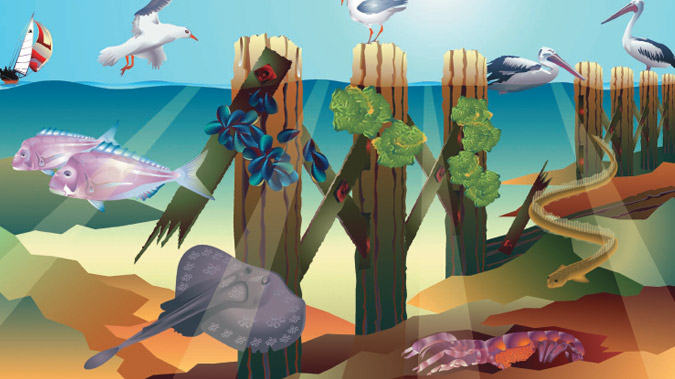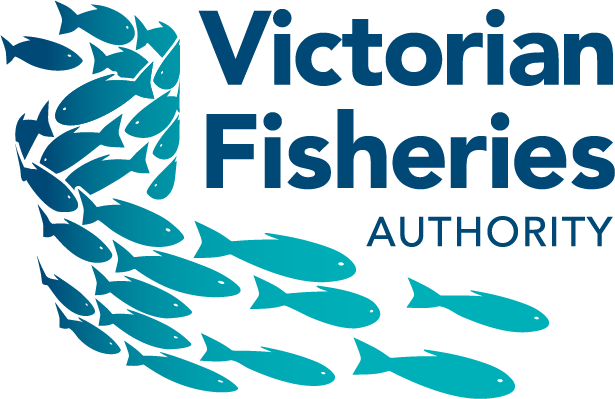Bays and Estuaries poster

Sheltered from the large waves and winds of the open coast, bays and estuaries are important environments around which many coastal towns and cities are located.
Estuaries occur where fresh and salt water is mixed, usually at the mouth of a river. In these environments there are a range of habitats with changes in salinity from freshwater to seawater. Hardy species that are able to tolerate the changing conditions live in these areas. Sand and mud built up at the mouth of rivers can lead to the formation of coastal lagoons.
Bays are much larger than estuaries and are often the remnants of ancient river valleys that have been flooded by rising sea levels. Estuaries and bays are highly productive systems with a number of shallow water plant species as well as large numbers of microscopic plants in the sediment and water. Many smaller animals feed on detritus formed from dead seagrasses, algae, and other plant material.
Key Species

Sea lettuce
(Ulva spp.)
Sea lettuce is a seaweed common in bays and estuaries as well as on the open coast. It is a bright green algae that grows rapidly during spring to cover large areas quickly before dying off during warm periods. It is eaten by many snails as
well as fish.

Bass Yabbies
(Callianassa ceramica) (other names - ghost shrimps, marine yabbies)
This common crustacean burrows in sediments and produces many of the small mounds seen on sand and mudflats in bays and estuaries. They are usually very pale, hence their alternate name
of ghost shrimp. They have one nipper larger than the other. Bass Yabbies feed on detritus found in the sand and are popular with fishers as bait.

Sparsely-spotted Stingaree
(Urolophus paucimaculatus)
This small ray is easily recognised by its white spots on its upper surface. Stingarees are very similar to sting rays but are smaller and have a rounded fin at the end of their tail. They have small-flattened
rows of teeth for crushing small crustaceans and molluscs. They also have one or two venomous spines and should be treated with caution.

Mussels
(Mytilus edulis)
Mussels can be found growing on solid structures along the coast and in bays and estuaries. They attach themselves by producing tough, sticky byssal threads and feed by filtering microscopic plankton from the water. They are a popular food
for many marine animals including seastars, crabs and fish.

Long-Fin Eel
(Anguilla reinhardtii)
Eels spend most of their adult lives in freshwater rivers and lakes but spend their first few months and late adult stages at sea. As eels mature they leave rivers and head to the sea, swimming all the way to the Coral Sea. Here
they spawn and die. Juveniles are carried down the coast by ocean currents before migrating back up rivers from estuaries to complete the cycle.

Snapper
(Chrysophrys auratus)
One of Victoria's most highly sought after fish, Snapper move into bays and estuaries at different times throughout their lives. Snapper spawn when water temperatures reach over 18°C. Tagged snapper released in Port Phillip Bay have
been caught as far away as Portland.

Silver Gulls
(Larus novaehollandiae)
While now very common, Silver Gulls or seagulls have not always been as abundant. Surveys on Mud Islands in the 1950's recorded only 6 pairs of gulls, compared with today's population of over one million. Being scavengers, gulls
have readily adapted to the increased availability of food from tips and fast food scraps, often to the detriment of other coastal birds. You can help to control seagull numbers by not feeding them when you visit a coastal area.

Pelican
(Pelecanus conspicillatus)
Pelicans are a common feature of bays and estuaries and can also live on inland waters. Pelicans catch fish by dipping their hooked bill and pouch into the water. They breed in large groups on offshore islands, such as Mud Islands
in Port Phillip Bay and are sensitive to disturbance by people and domestic animals.
Habitat Close Up
King George Whiting
King George Whiting are one of Victoria's most highly sought after species of fish. While King George Whiting are an important species for fishers and consumers, many gaps have existed in our understanding of this fish's life cycle.
Work undertaken by Fisheries Scientists at the Fisheries Research Branch (FRB) have given us new understanding of the life cycle of this fish species. Their work has also shown the importance of looking after habitat required by fish at different stages of their life cycle as well as the need for careful management of the fishery for both recreational and commercial fishers.
Juvenile King George Whiting are carried by currents from an area somewhere around Kangaroo Island. These tiny fish are transported as a part of the plankton community.
On reaching sheltered waters that support seagrasses, the juvenile King George Whiting grow into little fish that feed on the myriad of invertebrates living in the seagrass community. The seagrass plays an important role in allowing these fish to hide from potential predators.
After spending the first few years of life in the seagrass beds, they leave these shallow areas for the deeper waters of bays and estuaries where they remain for several years. Fish that are caught during this time are all pre-spawning fish and careful controls on the number of these animals caught is needed to ensure that enough young are allowed to mature. King George Whiting adults leave the bays and swim back to the spawning areas off the coast of South Australia to begin the whole process again.
Research by Fisheries Scientists at FRB is playing an important role in developing a greater understanding of the biology of many of our important recreational and commercial fish species and strategies to manage fisheries in a sustainable way.
For more information or to visit some of these magnificent marine habitats, please contact the:
Marine and Freshwater Discovery Centre, Queenscliff
Ph: 03 5258 3344
Email: marine.discovery@vfa.vic.gov.au
